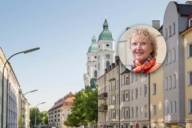
Ingrid Oxfort has been a city guide in Munich for over 30 years. She herself lives in the west of the city, but has lost her heart to Giesing district. Every year she designs new guided tours through this part of town and knows: It never gets boring here!
“I've always found Giesing exciting because it is so multifaceted: Tenement buildings stand next to old hostels and Stadelheim prison is right beside Perlacher Forst. There is something new to discover around every corner, every street is a completely different world. And the Heilig-Kreuz-Kirche (Church of the Holy Cross) is towering above it all.
Currently, I particularly enjoy walking through the Ostfriedhof (East cemetery) with its many prominent graves, such as those of Rudolf Mooshammer, Georg Kronawitter, Rex Gildo and psychiatrist Dr Gudden, who died together with the “Kini“ (Bavarian King Ludwig II). And Giesinger Bräu (brewery), whose labels were still pasted on by hand in a garage just a few years ago, is serious competition for the established breweries. Also Julian Hahn's “Hexenhäuschen” in my opinion, is an insanely great idea! Just a few stops further by bus and you stand in front of the Ukrainian Catholic Church, according to Byzantine rite – with a great surprise inside. By the way – it has a very dear and dedicated congregation.“
Since the Middle Ages, day labourers who were needed for large building projects, such as Altes Rathaus (Old Town Hall), have lived in Giesing. They stayed in hostel huts, as can still be seen today at the Feldmüllersiedlung residential area in Obere Grasstrasse, at the hostel huts on Auer Mühlbach or around Sommerstrasse. Nowadays, the neighbourhood is mainly known for its abundant nature and football – the Munich club 1860 has its stadium here, and the Bavarian team trains just a few streets away.
Football is not the only thing that plays a big role in Giesing – there's also beer to go with it. This is either served in one of the long-established pubs like the “Schau ma moi“ or actually brewed on site, like in the Giesinger Bräu. From a culinary point of view, Tegernseer Landstrasse is just as colourful as the neighbourhood itself – you can find just about anything here from Neapolitan cuisine to Michelin-starred restaurants.
When it comes to their cultural offerings, the people of Giesing are very committed and like to lend a hand: They simply assemble a wooden witch's cottage themselves, a local resident transforms a former privy building into a cool concert bar and the Giesinger Grünspitz (community project) is the meeting place in the community gardens.
The district is no less committed when it comes to their shop selection: You can taste fine wines at Weinberg, browse through second-hand fashion at Miramu or siebenmachen, and buy products made in Munich at Karusa. Shops in Giesing are mostly run by locals.
There is certainly no shortage of beautiful walks in Giesing. You can explore the tranquil Isar meadows or stroll along the waterfront to the Flaucher, discover the colourful rose garden or follow the Auer Mühlbach (stream) to Au district. In summer, you can swim around Wittelsbacherbrücke (bridge) or relax in the neighbouring Schyrenbad (public swimming pool).